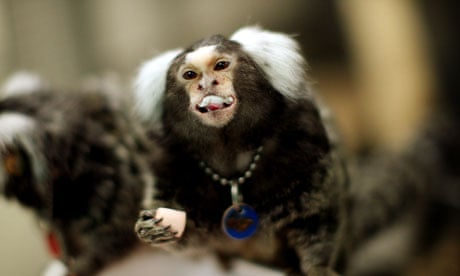The animal testing argument is trapped in a 1980s time warp. Thinking about it immediately makes me think about Body Shop peppermint foot lotion, Duran Duran, and tables on street corners with lurid, heartwrenching pictures of suffering animals.
Why does no one talk about it any more? Figures released this week showing that animal testing rose by 8% in the UK in 2012 will cause a small ripple of concern, which will then probably die down to a whimper. That's because we have tidied it up in our minds and put it away. Cosmetic testing: well, we don't do that any more. Medical research: while one feels sorry, obviously, for the poor animals, we're not prepared to forgo a cure for Parkinson's for our mother. That seems a pretty unanswerable conclusion.
We used to talk about it. In fact, we talked about it endlessly for 30 years and made huge amounts of progress, reaching the heady heights of an EU ban on cosmetic testing. But then it all became terribly complicated. Was cosmetic testing actually banned? What did we really think about medical research? In 2005, a crisis year in animal campaigning, a tiny group of animal rights activists brought the argument to a head by carrying out a number of stupid, offensive actions, including digging up the body of an animal breeder's grandmother. In doing so, they handed Tony Blair a reason to bring in a series of laws that sent many of them to prison. The movement was tainted with an air of emotional irrationality that is deeply unnerving to the British mentality, and that lingers to this day. We sealed it all off in a Blue Peter time capsule, and stopped talking about it.
But things have moved on, and there have been fundamental medical innovations, which means it is high time the debate is reopened. In 2007, the US National Research Council brought out a game-changing report called Toxicity Testing in the 21st Century, which drew an extraordinary picture of the testing regime of the future: laboratories full of colossal computing power that can trace the path of a substance through millions of human molecules, and will provide data based not on mice or fish, but actual human beings.
In the past few years substantial progress has been made in this area. In several fields, toxicology in particular, usable alternatives are within sight and researchers are developing a number of techniques, including models of human biochemical pathways, computer modelling of the relationship between doses and effects, and computational models that can predict toxicity in minutes, rather than the months that a traditional animal study requires. One scientist told me of university laboratories in the US where everything was done on computers and animals were regarded as old-fashioned.
Just as significantly, a growing number of scientists believe that animal testing, though useful, is far from ideal given the multiple genetic differences between the species. In a video released on Tuesday by Humane Society International (HSI), a number of researchers from institutions including Imperial College and Queen Mary University in London, and Aston University in Birmingham, tackled this problem head on.
"We need to start developing better, human-related models," says Geraldine Thomas, professor of molecular pathology at Imperial College. "Because, after all it's humans we treat in the clinic, not mice." A former director of the US National Institutes of Health, Dr Elias Zerhouni, last month told an audience that researchers had become too dependent on animal data. "We have moved away from studying human disease in humans," he lamented. "We need to refocus and adapt new methodologies for use in humans to understand disease biology in humans."
So, with all this in mind, and an agreement from the coalition government to reduce animal testing, how much, exactly, is the government spending on research in this vital field? HSI worked out that the grand total last year for this specific area of research was just over £2m. Corporations, in all fairness, have pushed harder and faster than governments at this door, themselves donating to research and also calling for more governmental action: last month, a consortium that included Dow, DuPont, ExxonMobil, L'Oréal, Procter & Gamble and Unilever issued a joint statement calling on the EU to invest at least €325m in research.
But the public need to get behind this too. Instead, worried we are misunderstanding something, full of conflict about that Parkinson's treatment for our mother, we allow the issue to be buried.
